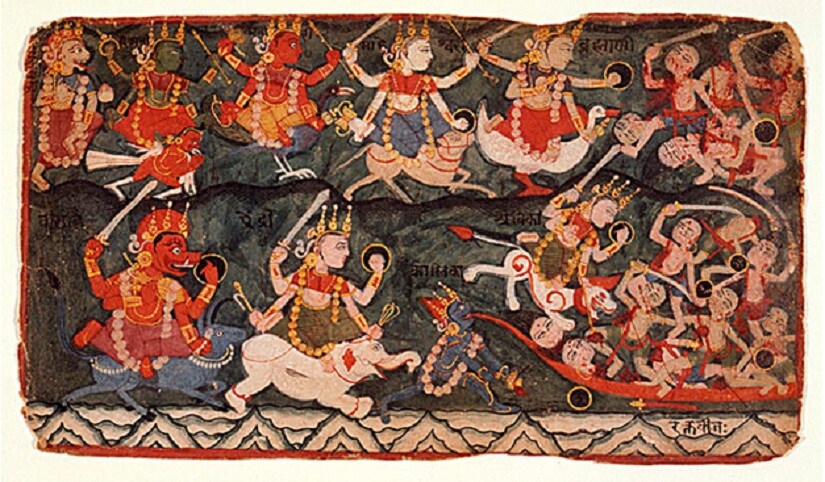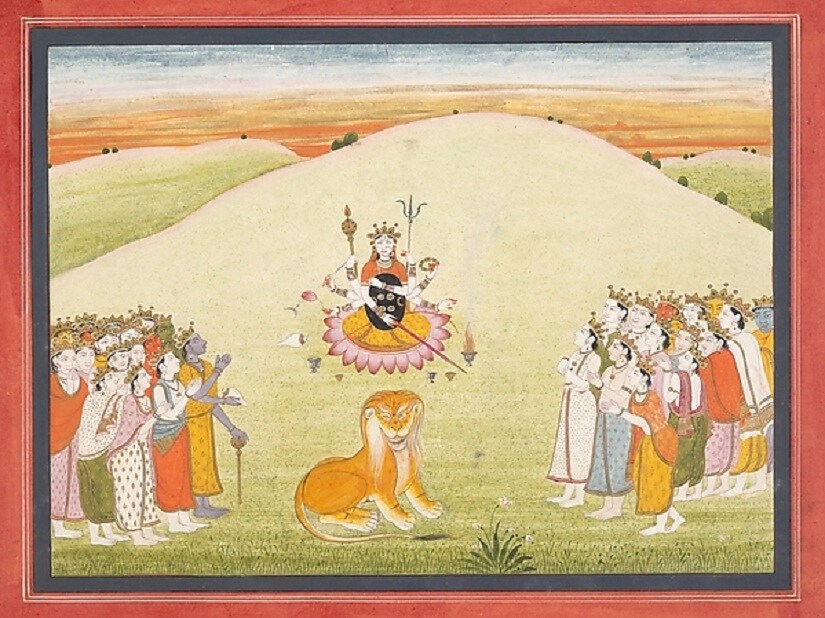Editor’s note: This is the second in a three-part series for Navratri, on how the Durga Saptashati shaped our knowledge of the goddess. Read the introduction and part one of the series here . *** Part II: Durga Saptashati — Key Takeaways for Contemporary Times Durga Saptashati is a composition that weaves in many basic tenets of life and spiritual thought in its narrative. This piece of poetry with its engaging narration and vivid imagery could suggest these tenets to those for whom the arcane and pithy language of the Upanishads was inaccessible. Some of the takeaways relevant for our times are discussed here. There is only Supreme Being — the Divine Goddess — Shakti, who is formless, but manifests in various forms. As discussed earlier, episode two of the Saptashati discusses the emergence of the Devi. The formless (nirguna) Devi assumes form (saguna) when the various gods of the then well-established Hindu pantheon — Shiva, Vishnu, Brahma and the devatas combine their energy (tejas). The tejas is nothing but the primordial Shakti who is the epitome of that who is ‘One’ — the eternal ‘Brahman’. There is no discord within the multiplicity of forms and paths that lead to the ‘One Truth’. [1] Shakti is the benevolent Mother who reincarnates/appears to re-establish the reign of Good over Evil. One of the cornerstones of Indian thought is that the formless Divine manifests at the behest of the devotees to defeat the forces of evil and re-establish the forces of good. The Saptashati reiterates this in its narrative, proclaiming that while Shakti is eternal and unborn, She, the benign mother, manifests herself again and again to protect the world [2]. It assures us that we need not despair for She will protect and guide us. The I within us is constantly engaged in a combat with good and bad. We have to transcend the I (aham) or ego to reach the Divine. The Saptashati reminds us that there is constant battle within us — a battle between our saintly and our demonic tendencies. It has to be won. We have to transcend our own nature — with all its wrong conceptions (the Mahisha within us) and move beyond the false sense of I (aham) to reach and merge with the higher divine consciousness for happiness and bliss. The arrangement of the episodes in the Saptashati symbolises the different stages of this elusive process of transcending the self. [caption id=“attachment_3045070” align=“alignnone” width=“825”]  Durga engaged in combat with Mahisha, reminiscent of our own internal combat. Sculpture at Mammallapuram Caves, India. Image courtesy: columbia. edu[/caption] Our ego and our pride keep resurfacing till they are annihilated. As mentioned earlier, in the third episode, Kali and the Matrikas kill the ferocious Raktabija (rakta is blood and bija is seed). Raktabija can be likened to our ego and our pride. Our ego keeps resurfacing in various demonic forms when hurt and is like the drops of blood which keep giving rise to Raktabija again and again. It has to be destroyed completely for us to be able to move forward. [caption id=“attachment_3045084” align=“alignnone” width=“825”]  Kali devouring all of Raktabija’s blood to annihilate him. Image courtesy: en.academic.ru[/caption] There is a multiplicity of purusharthas (goals) at various stages of our existence. The Indian tradition recognises that each one of us has a different goal based on the cosmic law of karma. Both, the desire for artha and moksha are valid as long as they are achieved by following the dharmic path. At the end of the frame narrative, Surath asks for the power to defeat his enemies in the current birth and for a kingdom in the next birth — artha. Samadhi requests for that knowledge which does not distinguish between the Divine and the I — moksha [3]. The Devi grants both. The Supreme Divinity can be and is visualised in a Feminine Form. There are many references in earlier Indian literature including the Vedas, where the Supreme Being is referred to as the Divine Mother. She, as prakriti (the active principle), is the cause of all creation in Samkhya thought, she as shakti is the energy of the Universe and she as maya conceals the true nature of reality in Vedanta. The Saptashati, however, brings together all forms of the Divine feminine, coalesces them into a whole and crystallises the fiercely independent Goddess as The Supreme Being — The Ultimate Godhead — The Divine Feminine. She is the Mahadevi who creates the Universe, pervades all creation (omnipresent) and sustains all creation, and then destroys it. She is the Mahadevi who possesses the powers of all the male gods combined (omnipotent). All divine beings are just manifestations of her — there is ‘no second one’ in this Universe [4]. The composition also brings together the vatsalya of the Matrikas with the fierceness of Kali to fuse into the great Mahadevi. [caption id=“attachment_3045094” align=“alignnone” width=“825”]  All Hail the Divine Goddess — Mahadevi. Image courtesy: metmuseum.org[/caption] Next: Part III — Re-imagining the Kumari Puja in households *** Notes: [1] “Indraṃ mitraṃ varuṇamaghnimāhuratho divyaḥ sa suparṇo gharutmān, ekaṃ sad viprā bahudhā vadantyaghniṃ yamaṃ mātariśvānamāhuḥ” “They call him Indra, Mitra, Varuṇa, Agni, and he is heavenly nobly-winged Garuda. To what is One, sages give many a title they call it Agni, Yama, Mātariśvan.” ( Rig Veda 1.164.46_)_ [2] Evam Bhagawathi devi saa nithyapi puna puna, Sambhooya kuruthe Bhoopa, Jagatha paripalanam. (Durga Saptashati — 12.36) [3] Thatho vavre nrupo rajyamavi bramsa janmani, Athrapi cha nijam rajyam hatha shatru balam balath. So api vaishyastato gyanam vavre nirvinamanasah, Mamethyahamithi pragna sangavichyuthikarakam. (Durga Saptashati — 13.17 and 13.18) [4] ‘ Aham vibhoothya bahubhiriha roopair yathasthadha. Tatsamhrutham mayaikeva thishtamyajou sthidhirobhava.’ (Durga Saptashati — 10.5) Garima is an independent business and strategy consultant and an Indic Studies enthusiast. She can be reached at garima.c@hotmail.com
Durga Saptashati is a composition that weaves in many basic tenets of life and spiritual thought in its narrative. This piece of poetry with its engaging narration and vivid imagery could suggest these tenets to those for whom the arcane and pithy language of the Upanishads was inaccessible. Some of the takeaways relevant for our times are discussed here.
Advertisement
End of Article
Written by Garima Chaudhry
Garima is an independent business and strategy consultant and mentors startups. In her corporate avatar, she spent 15+ years in various leadership roles at Capital18 (Network18), Topperlearning, Citi and TAS (Tata Administrative Services). An Indic Studies enthusiast, she can be reached at garima.c@hotmail.com. LinkedIn page: https://in.linkedin.com/in/garimac see more


)
)
)
)
)
)
)
)
)



